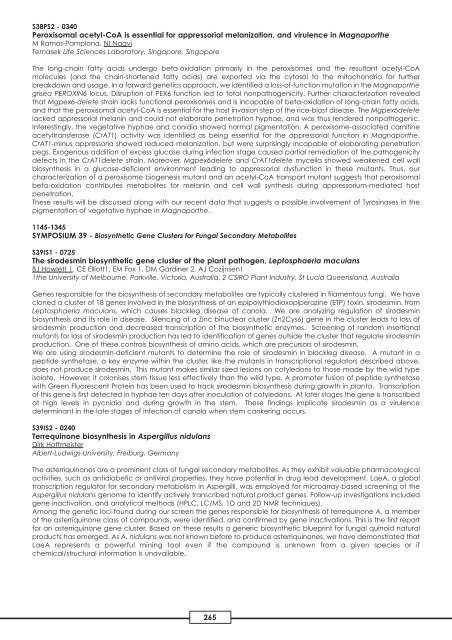Handbook Part 2 - International Mycological Association
Handbook Part 2 - International Mycological Association
Handbook Part 2 - International Mycological Association
Create successful ePaper yourself
Turn your PDF publications into a flip-book with our unique Google optimized e-Paper software.
S38PS2 - 0340<br />
Peroxisomal acetyl-CoA is essential for appressorial melanization, and virulence in Magnaporthe<br />
M Ramos-Pamplona, NI Naqvi<br />
Temasek Life Sciences Laboratory, Singapore, Singapore<br />
The long-chain fatty acids undergo beta-oxidation primarily in the peroxisomes and the resultant acetyl-CoA<br />
molecules (and the chain-shortened fatty acids) are exported via the cytosol to the mitochondria for further<br />
breakdown and usage. In a forward genetics approach, we identified a loss-of-function mutation in the Magnaporthe<br />
grisea PEROXIN6 locus. Disruption of PEX6 function led to total nonpathogenicity. Further characterization revealed<br />
that Mgpex6-delete strain lacks functional peroxisomes and is incapable of beta-oxidation of long-chain fatty acids,<br />
and that the peroxisomal acetyl-CoA is essential for the host invasion step of the rice-blast disease. The Mgpex6delete<br />
lacked appressorial melanin and could not elaborate penetration hyphae, and was thus rendered nonpathogenic.<br />
Interestingly, the vegetative hyphae and conidia showed normal pigmentation. A peroxisome-associated carnitine<br />
acetyltransferase (CrAT1) activity was identified as being essential for the appressorial function in Magnaporthe.<br />
CrAT1-minus appressoria showed reduced melanization, but were surprisingly incapable of elaborating penetration<br />
pegs. Exogenous addition of excess glucose during infection stage caused partial remediation of the pathogenicity<br />
defects in the CrAT1delete strain. Moreover, Mgpex6delete and CrAT1delete mycelia showed weakened cell wall<br />
biosynthesis in a glucose-deficient environment leading to appressorial dysfunction in these mutants. Thus, our<br />
characterization of a peroxisome biogenesis mutant and an acetyl-CoA transport mutant suggests that peroxisomal<br />
beta-oxidation contributes metabolites for melanin and cell wall synthesis during appressorium-mediated host<br />
penetration.<br />
These results will be discussed along with our recent data that suggests a possible involvement of Tyrosinases in the<br />
pigmentation of vegetative hyphae in Magnaporthe.<br />
1145-1345<br />
SYMPOSIUM 39 - Biosynthetic Gene Clusters for Fungal Secondary Metabolites<br />
S39IS1 - 0725<br />
The sirodesmin biosynthetic gene cluster of the plant pathogen, Leptosphaeria maculans<br />
BJ Howlett 1, CE Elliott1, EM Fox 1, DM Gardiner 2, AJ Cozijnsen1<br />
1the University of Melbourne, Parkville, Victoria, Australia, 2 CSIRO Plant Industry, St Lucia Queensland, Australia<br />
Genes responsible for the biosynthesis of secondary metabolites are typically clustered in filamentous fungi. We have<br />
cloned a cluster of 18 genes involved in the biosynthesis of an epipolythiodioxopiperazine (ETP) toxin, sirodesmin, from<br />
Leptosphaeria maculans, which causes blackleg disease of canola. We are analyzing regulation of sirodesmin<br />
biosynthesis and its role in disease. Silencing of a Zinc binuclear cluster (Zn2Cys6) gene in the cluster leads to loss of<br />
sirodesmin production and decreased transcription of the biosynthetic enzymes. Screening of random insertional<br />
mutants for loss of sirodesmin production has led to identification of genes outside the cluster that regulate sirodesmin<br />
production. One of these controls biosynthesis of amino acids, which are precursors of sirodesmin.<br />
We are using sirodesmin-deficient mutants to determine the role of sirodesmin in blackleg disease. A mutant in a<br />
peptide synthetase, a key enzyme within the cluster, like the mutants in transcriptional regulators described above,<br />
does not produce sirodesmin. This mutant makes similar sized lesions on cotyledons to those made by the wild type<br />
isolate. However, it colonises stem tissue less effectively than the wild type. A promoter fusion of peptide synthetase<br />
with Green Fluorescent Protein has been used to track sirodesmin biosynthesis during growth in planta. Transcription<br />
of this gene is first detected in hyphae ten days after inoculation of cotyledons. At later stages the gene is transcribed<br />
at high levels in pycnidia and during growth in the stem. These findings implicate sirodesmin as a virulence<br />
determinant in the late stages of infection of canola when stem cankering occurs.<br />
S39IS2 - 0240<br />
Terrequinone biosynthesis in Aspergillus nidulans<br />
Dirk Hoffmeister<br />
Albert-Ludwigs-University, Freiburg, Germany<br />
The asterriquinones are a prominent class of fungal secondary metabolites. As they exhibit valuable pharmacological<br />
activities, such as antidiabetic or antiviral properties, they have potential in drug lead development. LaeA, a global<br />
transcription regulator for secondary metabolism in Aspergilli, was employed for microarray-based screening of the<br />
Aspergillus nidulans genome to identify actively transcribed natural product genes. Follow-up investigations included<br />
gene inactivation, and analytical methods (HPLC, LC/MS, 1D and 2D NMR techniques).<br />
Among the genetic loci found during our screen the genes responsible for biosynthesis of terrequinone A, a member<br />
of the asterriquinone class of compounds, were identified, and confirmed by gene inactivations. This is the first report<br />
for an asterriquinone gene cluster. Based on these results a generic biosynthetic blueprint for fungal quinoid natural<br />
products has emerged. As A. nidulans was not known before to produce asterriquinones, we have demonstrated that<br />
LaeA represents a powerful mining tool even if the compound is unknown from a given species or if<br />
chemical/structural information is unavailable.<br />
265









